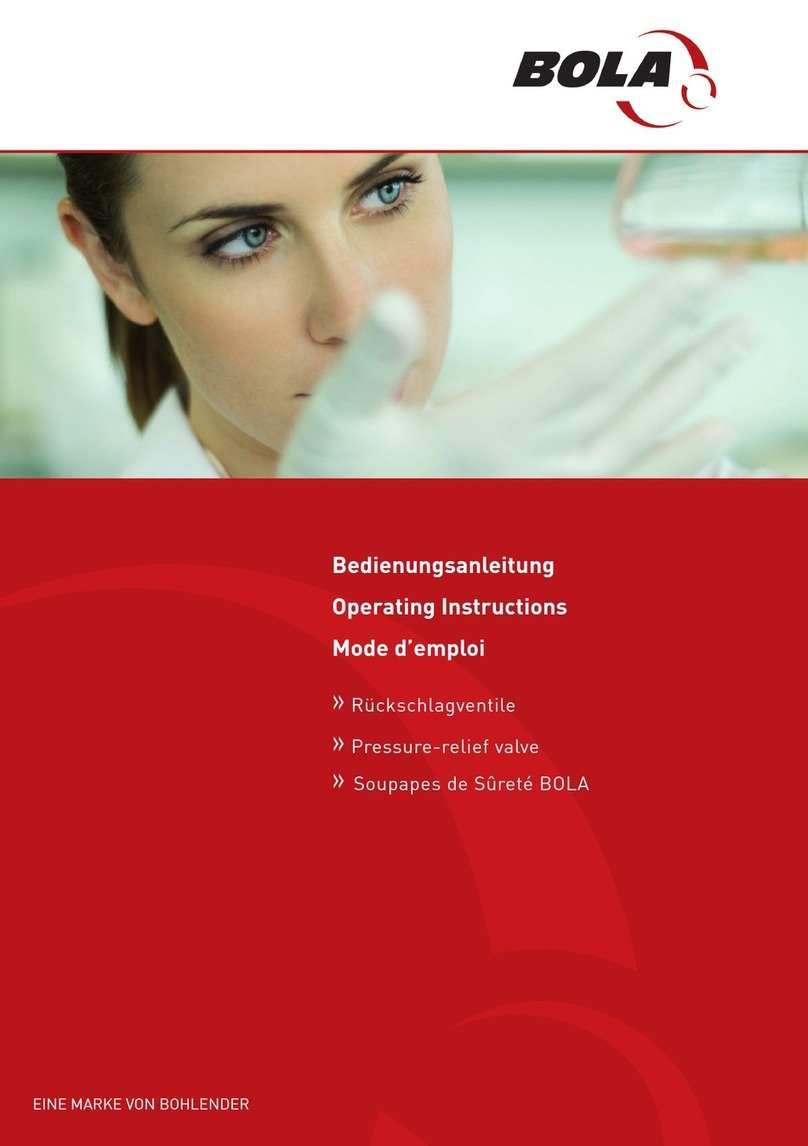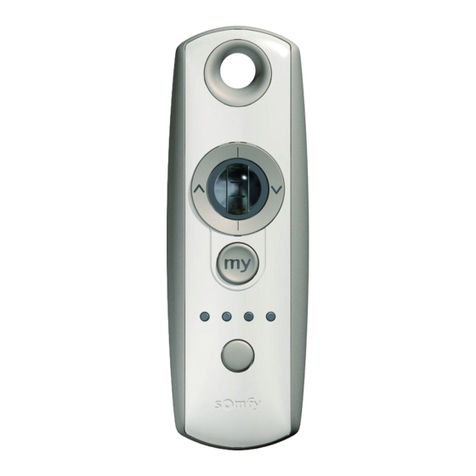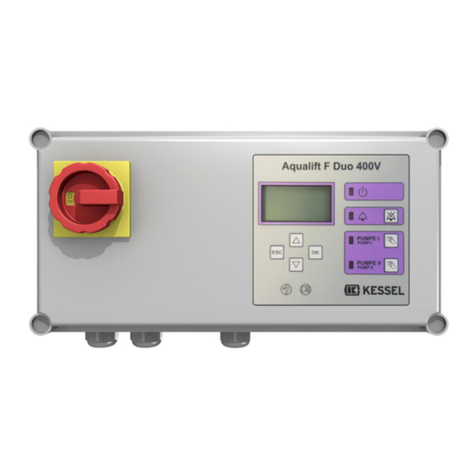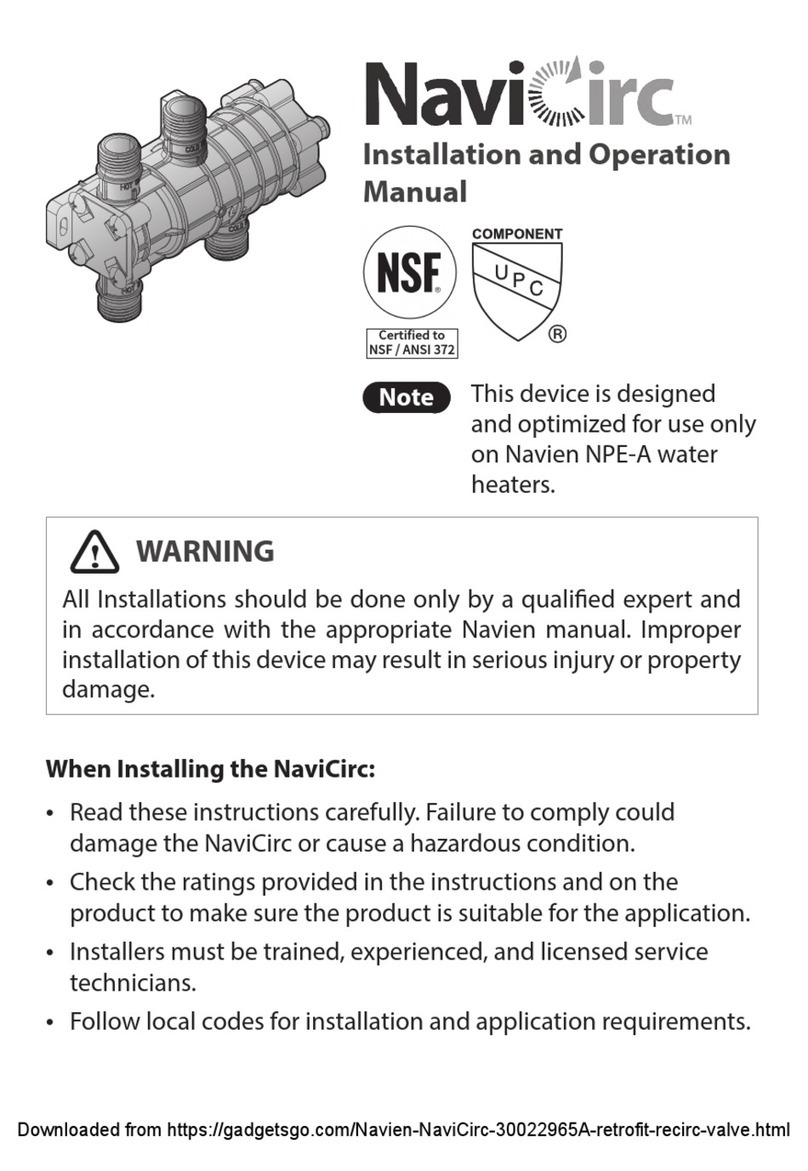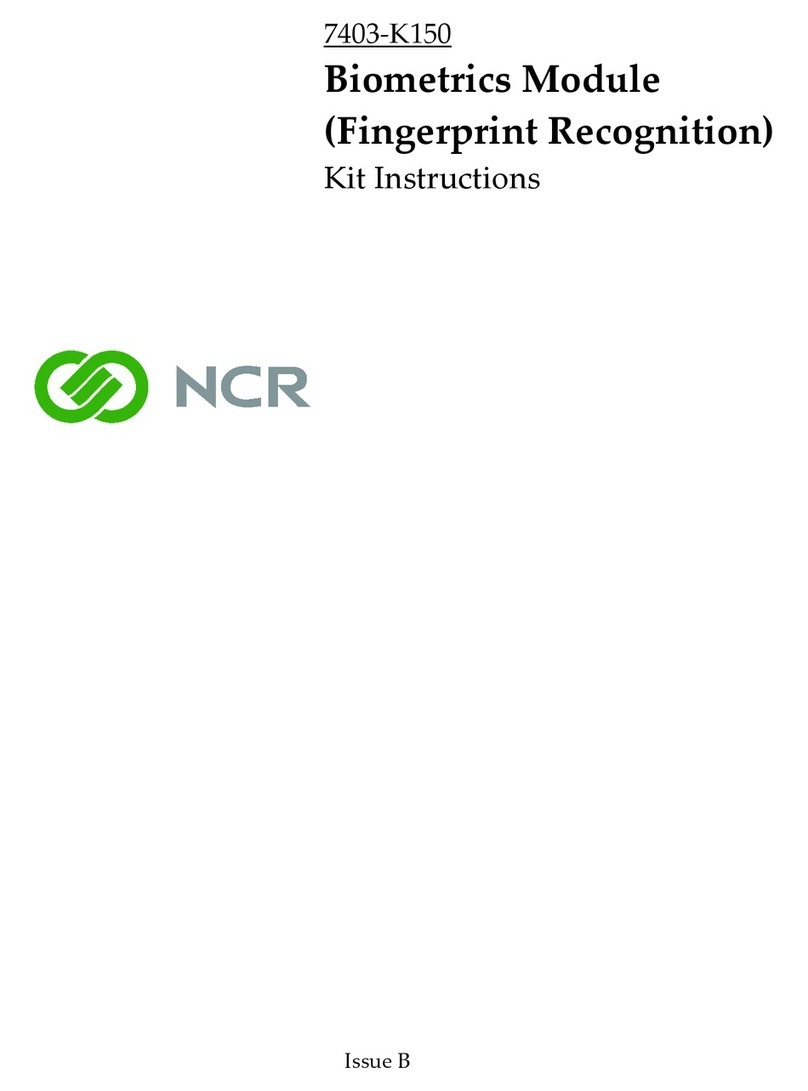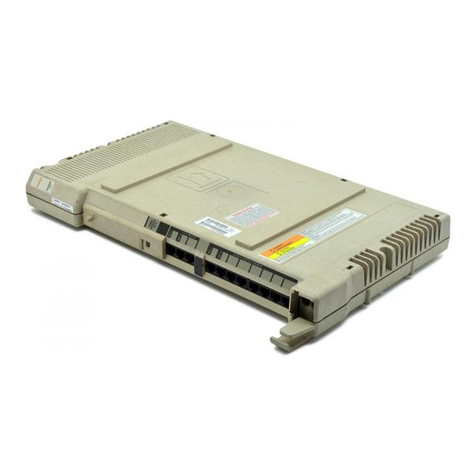Bola E 683-18 User manual

Bedienungsanleitung
Operating Instructions
Mode d’emploi
»Druckhalteventil
»Pressure-relief valve
» Vanne de maintien de la pression
EINE MARKE VON BOHLENDER

BOLA Druckhalteventil
BOLA Druckhalteventil mit manueller Entlüftung, Artikelnummer: E 683-18
BEDIENUNGSANLEITUNG
1. LIEFERUMFANG 2
2. SICHERHEITSHINWEISE 2
3. INBETRIEBNAHME 2
4. FUNKTIONSHINWEISE 3
5. SERVICE / PFLEGE 4
6. STÖRUNGSHINWEISE / REPARATUREN 5
7. ENTSORGUNGSHINWEISE 6
8. SPEZIFIKATIONEN 6
9. ERSATZ- / SONDERZUBEHÖR 6
Bitte lesen Sie alle im Folgenden aufgeführten Informationen aufmerksam durch. Wir bitten dringend, die Hinweise für die
Sicherheit, den Gebrauch und Wartung zu beachten.
1

BOLA Druckhalteventil
1. Lieferumfang
1 Druckhalteventil mit manueller Entlüftung
1 Bedienungsanleitung
2. Sicherheitshinweise
»Nehmen Sie ein schadhaftes Ventil nicht in Betrieb.
»Benutzen Sie das Ventil nur für Gase oder wasserähnliche Medien ohne Feststoffe.
»Verwenden Sie das Ventil nur bei Drücken zwischen 0 und 10 bar.
»Benutzen Sie das Ventil nur bei Medientemperaturen von – 20 °C bis + 150 °C.
»Beachten Sie die Durchflussrichtung. Der Richtungspfeil ist auf dem Gehäuse eingraviert.
»Beim Einsatz als Überströmventil leiten Sie das überströmende Medium kontrolliert ab.
» Vergewissern Sie sich, dass alle Bauteile Ihrer Anlage dem im Ventil eingestellten Druck standhalten.
» Prüfen Sie, ob Ihr gewünschter Haltedruck eingestellt ist.
» Bevor Sie das Druckhalteventil in Ihre Anlage ein- oder aus ihr ausbauen, muss die Zu- und die Ableitung am Ventil
drucklos sein.
2
3. Inbetriebnahme
Werksseitig ist ein Öffnungsdruck von 1,5 bar eingestellt. Möchten Sie einen anderen Öffnungsdruck einstellen, verfah-
ren Sie wie folgt:
»Lösen Sie die Feststellmutter (1) durch Drehen gegen den
Uhrzeigersinn und drehen diese bis an den Kopf der
Rändelschraube (2) hoch.
»Drehen Sie die Rändelschraube (2) mit zwei Fingern im
Uhrzeigersinn, bis Sie einen Widerstand spüren. Das
Druckhalteventil ist nun geschlossen.
»Verbinden Sie das Druckhalteventil durch einen Schlauch (20) an
der Eingangsseite mit einer Druckluft-Wartungseinheit. Die
Durchflussrichtung ist eingraviert.
»An die Ausgangsseite schließen Sie ebenfalls einen Schlauch (30)
an, den Sie in einem Gefäß mit Wasser enden lassen.
»Benutzen Sie hierfür eine geeignete Laborverschraubung mit
Gewinde GL 18, zum Beispiel von BOLA.
1
2
2
20 30

3
BOLA Druckhalteventil
» Beaufschlagen Sie das Druckhalteventil mit Ihrem gewünschten
Öffnungsdruck. Dieser muss zwischen 0,1 und 10 bar liegen.
» Drehen Sie die Rändelschraube (2) gegen den Uhrzeigersinn
langsam heraus, bis in Ihrem Gefäß Luftbläschen aus dem
Schlauch austreten. Der Öffnungsdruck des Ventils ist nun auf den
Druck Ihrer Druckluft-Wartungseinheit eingestellt.
» Kontern Sie die Rändelschraube (2) mit der Feststellmutter (1).
Drehen Sie die Feststellmutter (1) im Uhrzeigersinn mit zwei
Fingern fest.
» Prüfen Sie die Funktion der manuellen Entlüftung. Ziehen Sie an
der Zugstange (4). Der Durchgang wird freigegeben. Durch
Loslassen der Zugstange schließt das Druckhalteventil sofort
wieder.
»Info: Je größer der eingestellte Druck, desto fester müssen Sie an
der Zugstange (4) ziehen. Die Zugstange (4) lässt sich nur wenige
zehntel Millimeter bewegen.
4. Funktionsweise
Das Ventil wird über eine Membran mit einem O-Ring abgedichtet. Der Öffnungsdruck wird über eine
Federvorspannung mit der Rändelschraube (2) eingestellt. Je mehr diese Feder vorgespannt ist, bzw.
die Rändelschraube (2) zugedreht ist, desto höher ist der Öffnungsdruck.
Durch Ziehen an der Zugstange (4) heben Sie die Membran an. Der Durchgang wird kurzzeitig freigegeben.
2
2
1
4

4
BOLA Druckhalteventil
5. Service / Pflege
Spülen Sie das Druckhalteventil nach Gebrauch mit klarem Wasser nach. Zum Spülen das Ventil an einen
Wasseranschluss anschließen und den eingestellten Öffnungsdruck eventuell reduzieren. Der eingestellte
Öffnungsdruck muss kleiner sein als der Wasserdruck in der Zuleitung. Wünschen Sie eine Reinigung in demontiertem
Zustand, verfahren Sie wie folgt:
» Lösen Sie die Feststellmutter (1) und drehen Sie die
Rändelschraube (2) durch Drehen gegen den Uhrzeigersinn
komplett aus dem Aufsatz (4) heraus.
»Schrauben Sie die Zugstange (3) gegen den Uhrzeigersinn komplett
aus dem Aufsatz (4) heraus.
» Schrauben Sie mit einem Schraubendreher (Klingenbreite 3,5 mm)
durch Drehen gegen den Uhrzeigersinn alle vier Schrauben aus dem
Druckhalteventil heraus.
» Nehmen Sie die Halteplatte (5) ab.
» Nehmen Sie den Aufsatz (4) ab.
4
1
2
3
4
5
4

5
BOLA Druckhalteventil
» Entnehmen Sie die Druckplatte (6) und die Druckfeder (7). Ziehen
Sie die Membrane (8) aus dem Gehäuse (9) heraus. Hierfür ist kein
Werkzeug nötig.
» Achtung: Alle inneren Flächen des Gehäuses (9) und alle unteren
Flächen der Membrane (8) sind Dichtflächen. Sind diese
beschädigt, ist die Funktion des Druckhalteventils nicht mehr
gewährleistet!
Wir empfehlen den O-Ring in der Membrane nicht zu demontieren.
Alle Einzelteile können mit handelsüblichen, nicht scheuernden Reinigungsmitteln gereinigt werden.
Der Zusammenbau erfolgt in umgekehrter Reihenfolge.
6. Störungshinweise / Reparaturen
Die im Folgenden aufgezeigten Hinweise zur Beseitigung von möglichen Störungen sollen Ihnen helfen, mögliche
Ursachen für die Störungen selbst zu erkennen und eventuell zu beseitigen. Sollte ein Schaden vom Anwender nicht
zu beheben sein, bitten wir um telefonische Rücksprache. Wir werden dann gerne versuchen, Ihnen auf diesem Wege
zu helfen. Sollte dies dann endgültig zu keinem positiven Ergebnis führen, bitten wir das Ventil in gereinigtem Zustand
zurückzusenden. Wir werden dann prüfen, inwieweit eine kostengünstige Reparatur möglich ist.
Sie wollen einen Mindestdruck in Ihrer Anlage halten.
Beanstandung Ursache und Abhilfe
Das Ventil öffnet sich
nicht.
»Die Durchflussrichtung des Ventils wurde nicht beachtet.
Prüfen Sie Ihre Anschlüsse und tauschen Sie diese wenn nötig.
» Der eingestellte Öffnungsdruck des Ventils ist zu hoch.
Er muss kleiner sein als Ihr Anlagendruck. Verringern Sie den
Öffnungsdruck Ihres Druckhalteventils.
Das Ventil schließt nicht
mehr.
»Es sind Feststoffe im Ventil.
Vermeiden Sie Feststoffe durch den Einbau eines Filters.
»Das Medium ist zu dickflüssig.
Das Druckhalteventil ist hierfür nicht geeignet.
»Die Membrane ist defekt.
Tauschen Sie die Membrane aus.
6
7
8
9

6
BOLA Druckhalteventil
7. Entsorgungshinweise
Das BOLA Druckhalteventil sowie die Verpackung bestehen aus recyclingfähigen Materialien und können deshalb den
ortsüblichen Entsorgungsstellen zugeführt werden. Nähere Angaben zu den verwendeten Materialien entnehmen Sie
bitte den nachfolgenden Spezifikationen.
8. Spezifikationen
BOLA Druckhalteventil mit manueller Entlüftung
Artikel-
Nummer
Anschluss-
gewinde
Durchgangs-
bohrung
Material Temperatur-
beständigkeit
Anwendungsdruck Werks-
einstellung
E 683-18 GL 18 Ø 6 mm PTFE
PPS
Edelstahl
-20 °C bis
+ 150 °c
0,1 bis 10 bar 1,5 bar
9. Ersatz- / Sonderzubehör
»siehe Seite 18

7
BOLA Pressure-Relief Valve
BOLA Pressure-Relief Valve with manual ventilation, Cat.-No.: E 683-18
Operating Instructions
1. Supplied with 2
2. Security Instructions 2
3. Taking into operation 2
4. Mode of function 3
5. Service / Maintenance 4
6. Disturbances / Repair 5
7. Waste Disposal 6
8. Specifications 6
9. Accessories 6
Please read the information listed below thoroughly. We urgently ask you to observe the information and advice about
security, use and maintenance.

8
BOLA Pressure-Relief Valve
1. Supplied with
1 Pressure-relief valve with manual ventilation
1 Operating Instructions
2. Security Instructions
»Do not take a damaged valve into operation.
»The valve is suitable only for gas or watery products without any solids.
»Observe the working pressure range from 0 up to 10 bar during operation.
»The valve is only suitable for product temperatures from –20 °C up to + 150 °C.
»The flow direction has to be observed. It is marked with an arrow on the housing.
»If used as an overflow-valve, a controlled deviation of the overflowing medium has to be ensured.
» Make sure that all components of your installation withstand the pressure that has been adjusted on the valve.
» Make sure that the requested holding pressure is adjusted.
» Prior to installation or removing the valve, the inlet and outlet to/from the valve have to be pressureless.
3. Taking into operation
The opening pressure is factory set to 1.5 bar. Any other opening pressure can be adjusted as follows:
»Loosen the locking nut (1) by turning it counterclockwise upwards
the adjusting screw (2).
»Turn the adjusting screw (2) clockwise with two fingers until you
feel a resistance. The pressure-relief valve is now closed.
»Connect the inlet of the pressure relief valve with a tubing to a
compressed air service unit or a pressure gauge. The flow direction
is marked with an engraved arrow.
»Connect the outlet with a tubing (30). Put the tubing end in a
vessel with water.
»Fix the tubes with BOLA Laboratory Screw Joints GL 18.
1
2
2
20 30

9
BOLA Pressure-Relief Valve
» Load the requested opening pressure to the pressure relief valve. It
can range between 0.1 and 10 bar.
» Turn the adjusting screw (2) slowly counterclockwise. Watch the
water. As soon as bubbles can be seen in the water, the valve is
open. The valve’s opening pressure is now set to the same pressure
as your compressed air service unit.
» Fix the adjusting screw (2) with the locking nut (1). Tighten the
locking nut (1) by turning it clockwise with two fingers.
» Check whether the manual ventilation works. Pull the toggle (4).
The passage is open. Upon releasing the toggle, the passage is
closed immediately.
»Please note: the higher the pressure is set, the more power is
needed to pull the toggle (4). It can be moved only for a few tenths
of a millimetre.
4. Mode of function
The valve is sealed by a membrane with an integrated O-ring. The opening pressure is set by turning the adjusting screw
(2) and thus changing the tension applied to the integrated spring. The more the spring is bent respectively the stronger
the adjusting screw (2) is closed, the higher is the opening pressure.
By pulling the toggle (4), the membrane is lifted. The passage is open for a short time.
2
2
1
4

10
BOLA Pressure-Relief Valve
5. Service / Maintenance
Rinse the pressure-relief valve with clear water after use. Connect the valve to a tap for rinsing. It is possible that the
adjusted opening pressure has to be reduced as it has to be lower than the water pressure in the water line. For cleaning
of the single components, please observe the following steps for correct disassembly:
» Loosen the locking nut (1). Remove the adjusting screw (2) from
the top section (4) by turning it counterclockwise.
»Remove the toggle (3) from the top section (4) by turning it
counterclockwise.
» Remove all four screws with a screw driver (blade with 3.5 mm) by
turning them counterclockwise.
» Remove the holding plate (5).
» Remove the top section (4).
4
1
2
3
4
5
4

11
BOLA Pressure-Relief Valve
» Remove the pressure plate (6) and the pressure spring (7).
Pull the membrane (8) out of the housing (9).
Tooling is not necessary.
» Attention: All inner surfaces of the housing (9) and the lower side
of the membrane (8) are sealing surfaces. If the surface is
damaged, the functionality of the pressure relief valve cannot be
guaranteed! Do not remove the O-ring from the membrane.
All single components can be cleaned with commercial, non-abrasive detergents.
Assembly is made in reverse order.
6. Disturbances / Repair
The following information shall help you to recognise and, if possible, to eliminate possible reasons for disturbances
by yourself. If you are not able to handle the disturbance, please give us a call. We will then try to help you this way. If
then, a solution to your problem cannot be found, we will ask you to return the cleaned valve in the original packing to
us. Then we will check whether a cost-effective repair is possible.
A certain minimum pressure shall be maintained in your installation.
Objection Reason and help
The valve does not open »The flow direction of the valve has not been observed.
Check the connections and change their order if necessary.
» The adjusted opening pressure is too high. It has to be lower than the pressure within
your installation. Reduce the opening pressure of the valve.
The valve does not close. »There are solids inside the valve.
Solids inside the valve can be avoided by adding a filter to the inlet.
»The product is too viscous.
The pressure relief valve is not suitable for such a product.
»The membrane is defective. Exchange it.
6
7
8
9

12
BOLA Pressure-Relief Valve
7. Waste Disposal
The BOLA pressure relief valve as well as its packing consist of recyclable material.
Please take further information on the materials used from the following specifications.
8. Specifications
BOLA Pressure Relief Valve with manual Ventilation
Cat.No. Connecting
Thread
Bore dia. Material Temperature
resistance
Pressure range Factory
setting
E 683-18 GL 18 Ø 6 mm PTFE
PPS
stainless steel
from -20 °C to
+ 150 °c
0,1 bis 10 bar 1,5 bar
9. Accessories
»see page 18

13
BOLA Vanne de Maintien de la Pression
BOLA Vanne de Maintien de la Pression avec Aération manuelle, Réf.:E 683-18
MODE D’EMPLOI
1. Volume de livraison 2
2. Instructions de sécurité 2
3. Mise en Fonction 2
4. Mode de fonction 3
5. Service / Maintenance 4
6. Perturbations / Réparations 5
7. Enlèvement du déchet 6
8. Spécification 6
9. Pièces de rechange / Accessoires 6
Veuillez lire précisément toutes les informations suivantes. Nous vous prions d’observer les indications sur
sécurité, usage et maintenance.

14
BOLA Vanne de Maintien de la Pression
1. Volume de livraison
1 Vanne de maintien de la pression avec aération manuelle
1 Mode d’emploi
2. Instructions de sécurité
»Ne mettez pas de vanne défectueuse en service.
»La vanne ne doit être utilisée que pour des substances hydroïdes ou des gaz sans de matière solide.
»N’utilisez la vanne qu’avec de la pression de 0 jusqu’à 10 bar.
»La vanne est appropriée pour des produits avec températures de – 20 °C jusqu’à + 150 °C.
»Respectez la direction de passage. La flèche de direction est ciselée sur la boîte.
»Si vous utilisez cette vanne comme soupape de sûreté il faut dériver le produit qui déborde.
» Assurez vous que tous les composants installés résistent à la pression ajustée.
» Vérifiez que la pression désirée est ajustée.
» Dépressurisez les conduites d’alimentation avant de monter ou démonter la vanne.
3. Mise en Fonction
La pression d’ouverture est préréglée à 1,5 bar. Vous pouvez ajuster une autre pression comme suite:
»Dévissez la vis de réglage (1) en tournant à gauche jusqu’à la tête
de l’écrou de blocage (2).
»Tournez l’écrou de blocage (2) avec deux doigts. La vanne est
fermée aussitôt que vous sentez une résistance.
»Raccordez l’arrivée de vanne (20) avec un manomètre en
connectant un tuyau au col GL. La direction de passage doit être
respectée.
»Connectez un tuyau à la sortie de la vanne (30). Mettez ce tuyau
dans un vase rempli d’eau.
»Utilisez des BOLA Raccords à vis de Laboratoire GL 18 pour
raccorder de tuyaux.
1
2
2
20 30

15
BOLA Vanne de Maintien de la Pression
» Pressurisez la vanne avec la pression d’ouverture désirée. Cette
pression doit être entre 0,1 et 10 bar.
» Tournez lentement l’écrou de blocage (2) à droite jusqu’à ce que
vous voyez des bulles dans l’eau. Maintenant, la vanne est ajustée
à la pression d’ouverture désirée.
» Assurez l’écrou de blocage (2) avec la vis de réglage en la tournant
à droite avec deux doigts.
» Contrôlez la fonction de l’aération manuelle par tirer la manette (4)
pour ouvrir le passage. Aussitôt que vous lâchez la manette, le
passage se ferme immédiatement.
»Notez: Si une haute valeur de pression est ajustée, vous devez
tirer la manette (4) plus fortement.
4. Mode de fonction
La vanne est étanchée par une membrane avec un joint torique intégré. La pression d’ouverture est ajustée par un étau à
ressort et réglée par l’écrou de blocage (2). Le plus que l’écrou est fermé, le plus grande est la pression d’ouverture. En
tirant la manette, vous levez la membrane et ouvrez la vanne complètement.
2
2
1
4

16
BOLA Vanne de Maintien de la Pression
5. Service / Maintenance
Rincez la vanne avec de l’eau claire après usage. Pour rincer, raccordez la vanne à une prise d’eau. Eventuellement, vous
devez réduire la pression ajustée. La pression d’ouverture doit être plus petite que la pression de votre source d’eau.
Pour nettoyer les seuls composants, vous pouvez démonter la vanne comme suite:
» Dévissez la vis de réglage (1) en tournant à gauche. Enlevez l’écrou
de blocage (2) complètement en la tournant à gauche.
»Enlevez complètement la manette (3) en tournant à gauche.
» Devissez complètement les 4 vis avec un tournevis (largeur de
lame: 3,5 mm).
» Détachez la plaque de support (5).
» Détachez la partie supérieure (4).
4
1
2
3
4
5
4

17
BOLA Vanne de Maintien de la Pression
» Enlevez la plaque de pression (6) et l’étau à ressort (7). Tirez la
membrane (8) en bas du boîtier (9).
Il vous ne faut aucun outil.
» Attention: toutes les surfaces intérieures du boîtier (9) ainsi que
les surfaces inférieures de la membrane (8) sont des surfaces
d’étanchéité. Un dommage de ces surfaces peut causer un défaut
de la vanne!
Nous recommandons de pas démonter le joint torique de la
membrane.
Nettoyez les composants avec des détergents usuels. Evitez les détergents dégraissants.
L’assemblage est fait en ordre inversé.
6. Perturbations / Réparations
Les informations suivantes pour enlever des perturbations possibles ont été faites pour vous aider à reconnaître et
enlever les raisons des perturbations par vous-mêmes. S’il y a un problème que vous ne pouvez pas solutionner, nous
vous prions de nous appeler et nous essayerons à vous aider. Si cela ne mène pas à un résultat positif, nous vous prions
de nous retourner la propre vanne dans l’emballage original. Nous vérifions après si une réparation est possible.
Une pression minimum doit être maintenu dans votre système:
Problème Raison et réparation
La vanne n’ouvre pas. »La direction de passage n’est pas respectée.
Vérifiez les raccords et changez-les si nécessaire.
» La pression d’ouverture ajustée est trop haute.
Adaptez-la à la pression de votre système.
La vanne ne ferme pas. »Des matières solides se trouvent dans la vanne.
Evitez-les avec un filtre connecté à l’alimentation.
»Le produit est trop visqueux.
La vanne n’est pas appropriée pour des milieux visqueux.
»La membrane est défectueuse. Echangez la membrane.
6
7
8
9

18
BOLA Vanne de Maintien de la Pression
7. Enlèvement du déchet
La BOLA Vanne de Maintien de la Pression avec Aération manuelle ainsi que les emballages sont faits en matériaux
recyclables. Veuillez prendre plusieurs informations sur les matériaux utilisés des spécifications suivantes.
8. Spécification
BOLA Vanne de Maintien de la Pression avec Aération manuelle
Réf. Cols GL Dia. de la
passage
Matériaux Limitations de
température
Pression
d’ouverture
Pression
préréglée
E 683-18 GL 18 Ø 6 mm PTFE
PPS
stainless steel
from -20 °C to
+ 150 °c
0,1 bis 10 bar 1,5 bar
9. Zubehör / Accessories / Accessoires
Beschreibung Description Description Artikel-Nr.:
Cat.-No.:
Réf.
Abbildung:
Picture:
Image:
BOLA PTFE-Schlauch BOLA PTFE Tubing BOLA TUBES PTFE S 1810 - …
BOLA PFA-Schlauch BOLA PFA Tubing BOLA TUBES PFA S 1811 - …
BOLA FEP-Schlauch BOLA FEP Tubing BOLA TUBES FEP S 1815 - …
BOLA Laborverschraubungen HT (High Temp) BOLA Laboratory Screw Joints HAT (High
Temp)
RACCORDS A VIS DE LABORATOIRE
HT (HAUT TEMPERATURES)
D 629 - …

V. 01.01.2017
BOLA
EINE MARKE DER
BOHLENDER GmbH
Waltersberg 8
D 97947 Grünsfeld
Germany
Telefon: +49 (0) 93 46 - 92 86-0
Fax: +49 (0) 93 46 - 92 86-51
Mail: info@bohlender.de
www.bola.de
Table of contents
Languages:
Other Bola Control Unit manuals
Popular Control Unit manuals by other brands
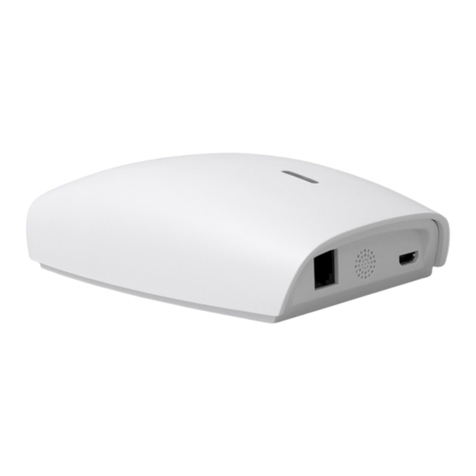
YOODA
YOODA Smart Home 2 manual

Kunbus
Kunbus cRIO PB installation instructions
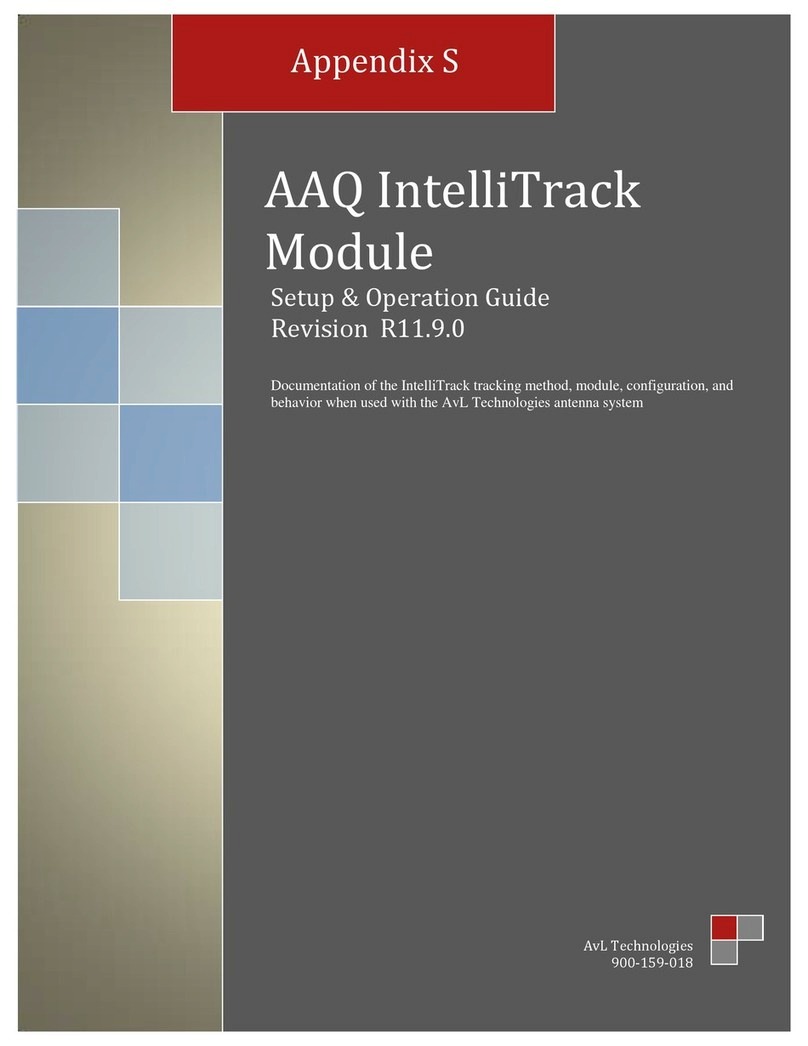
AvL Technologies
AvL Technologies AAQ IntelliTrack Module Setup & operation guide

Siemens
Siemens SITOP UPS1600 Getting started
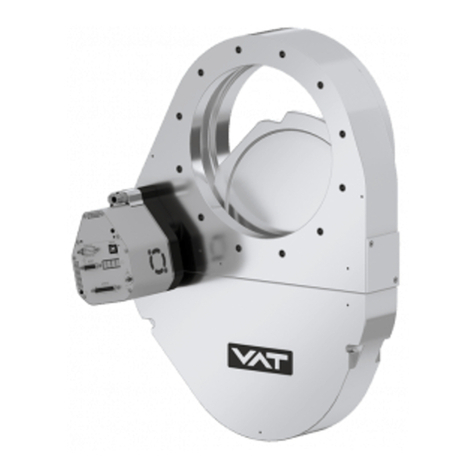
VAT
VAT 653 Series Installation, operating, & maintenance instructions
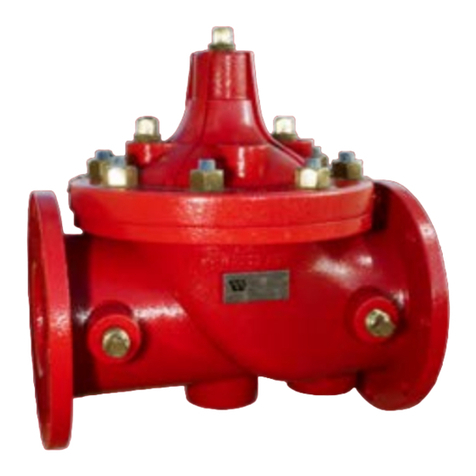
Watts
Watts AMES LF981GD Series manual

Mitsubishi Electric
Mitsubishi Electric AJ65SBTB2N-16S user manual
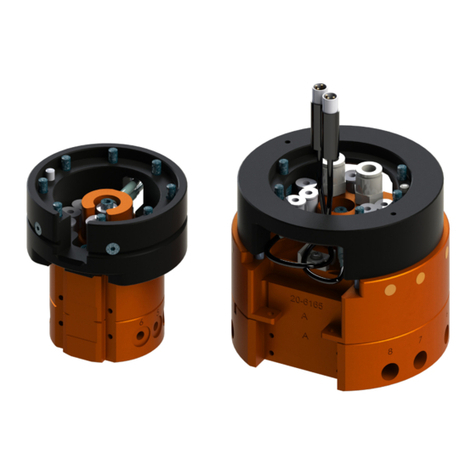
ATI Technologies
ATI Technologies QC-11HM manual
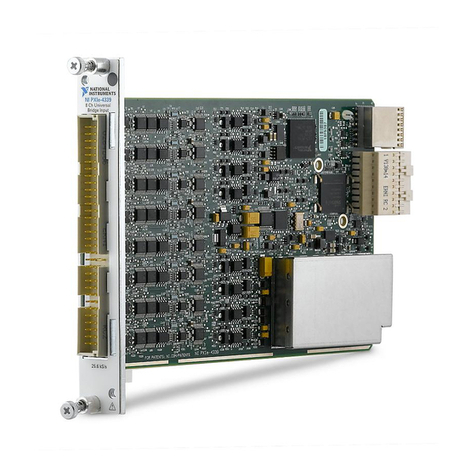
National Instruments
National Instruments PXIe-4339 installation guide
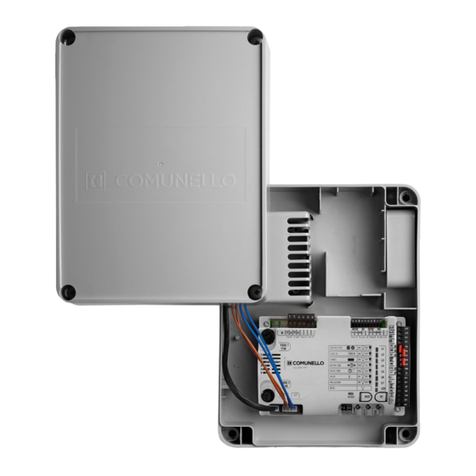
Comunello Automation
Comunello Automation QUAD-24V-HP Installation and user manual

Burkert
Burkert 2103 Series quick start

Bticino
Bticino Terraneo 391612 instruction sheet
